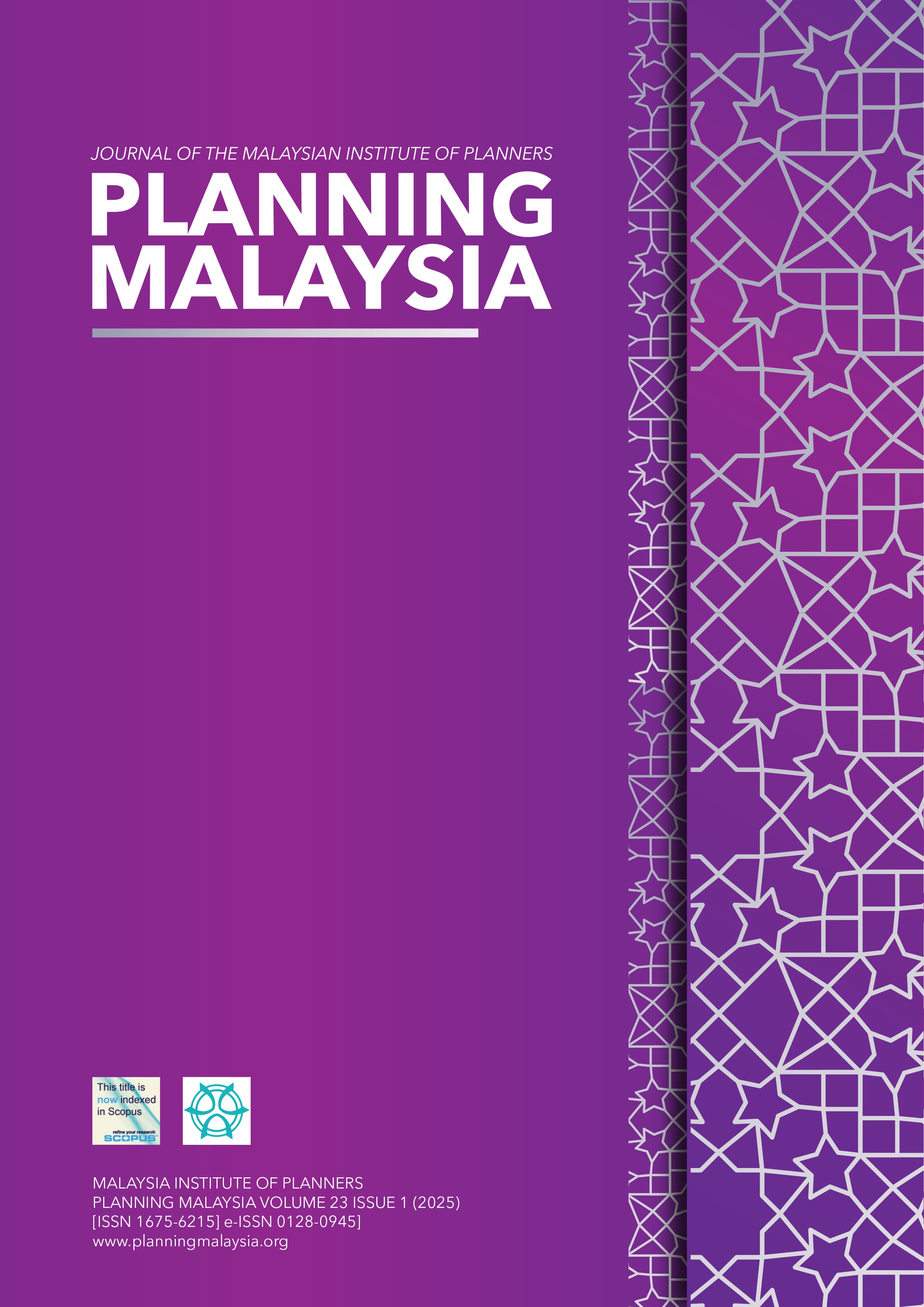THE ENDURING LEGACY OF MASHRABIYA IN ISLAMIC ARCHITECTURE AND DESIGN
DOI:
https://doi.org/10.21837/pm.v23i35.1696Keywords:
Mashrabiya, Architecture, Design, Traditional, ModernAbstract
This research investigates the multifaceted significance of Mashrabiya, a traditional architectural element found throughout the Islamic world. Employing a design typology approach, it delves into its historical, social, artistic, and environmental aspects. The core focus lies in the typology's impact on functionality, including solar control, ventilation, and humidity regulation. Cultural and social values embedded within the design and craftsmanship are also explored. The study emphasizes design strategies for incorporating Mashrabiya in both historical and contemporary buildings, analysing its use as a primary decorative element. A comparative analysis with traditional Malay house screening is included. six case studies, encompassing traditional and modern applications, will be examined alongside the element's historical background, installation methods, material usage, and modern adaptations in hotels and boutiques. Finally, the artistic representation and construction techniques, particularly its connection to abstract geometry, will be explored. This comprehensive investigation aims to highlight the rich history of Mashrabiya, establish it as a valuable source of inspiration for future designers, and bridge the knowledge gap between traditional and modern forms.
Downloads
References
Abdel, N., Mohamed, G., & Ali, W. H. (2014). Traditional Residential Architecture in Cairo from a Green Architecture Perspective. 16.
Abdelkader, R., & Park, J. (2018). Spatial Principles of Traditional Cairene Courtyard Houses in Cairo. May, 245–252. DOI: https://doi.org/10.3130/jaabe.17.245
About Hawa Mahal | Hawa Mahal. (n.d.). Retrieved March 11, 2024, from http://www.hawa-mahal.com/information-about-hawa-mahal/
AD Classics: Institut du Monde Arabe / Enrique Jan + Jean Nouvel + Architecture-Studio | ArchDaily. (n.d.). Retrieved March 10, 2024, from https://www.archdaily.com/162101/ad-classics-institut-du-monde-arabe-jean-nouvel
Amer, O., Boukhanouf, R., & Ibrahim, H. G. (2015). A Review of Evaporative Cooling Technologies. International Journal of Environmental Science and Development, 6(2), 111–117. https://doi.org/10.7763/ijesd.2015.v6.571 DOI: https://doi.org/10.7763/IJESD.2015.V6.571
Amrousi, M. El. (2017). Masdar City : As an Example of Sustainable Facades and Building Skins. 6(1), 40–44. https://doi.org/10.18178/ijscer.6.1.40-44 DOI: https://doi.org/10.18178/ijscer.6.1.40-44
Ashour, A. F. (2018). Islamic architectural heritage: Mashrabiya. WIT Transactions on the Built Environment, 177, 245–253. https://doi.org/10.2495/IHA180211 DOI: https://doi.org/10.2495/IHA180211
Bagasi, A. A. (2022). Investigation of the ventilation and thermal performance of mashrabiya for residential buildings in the hot-humid climate of Saudi Arabia.
Bagasi, A. A., & Calautit, J. K. (2020). Experimental field study of the integration of passive and evaporative cooling techniques with Mashrabiya in hot climates. Energy and Buildings, 225, 110325. https://doi.org/10.1016/j.enbuild.2020.110325 DOI: https://doi.org/10.1016/j.enbuild.2020.110325
Baydoun, Z., Alghamdi, N. A., & Kamarudin, Z. (2023). THE ISLAMIC ART AND DESIGN ELEMENTS APPLIED IN THE ISLAMIC CITY, A CASE STUDY OF PUTRAJAYA ISLAMIC CITY. PLANNING MALAYSIA, 21(1), 314–328. https://doi.org/10.21837/PM.V21I25.1241 DOI: https://doi.org/10.21837/pm.v21i25.1241
Baydoun, Z., Norishah, T., Baydoun, R., & Adam, M. (2024). Placement Principles of Islamic Calligraphy in Architecture: Insights from the Al-Hambra and Al-Azem Palaces. Buildings 2024, Vol. 14, Page 2025, 14(7), 2025. https://doi.org/10.3390/BUILDINGS14072025 DOI: https://doi.org/10.3390/buildings14072025
Bayt Al-Suhaymi | Know More About House of Suhaymi in Cairo. (n.d.). Retrieved March 10, 2024, from https://www.etbtoursegypt.com/Wiki/Egypt-Travel-Guide/bayt-al-suhaymi-house-of-suhaymi
Dariyadi, M. W., Baydoun, Z., Kamarudin, Z., & Murtadho, N. (2022a). The Islamic art and design elements applied in the Islamic city. City, Territory and Architecture, 9(1), 314–328. https://doi.org/10.1186/s40410-022-00155-4 DOI: https://doi.org/10.1186/s40410-022-00155-4
Headley, D., Almerbati, N., Ford, P., & Taki, A. (2015). F o esea h to p a ti e : e plo i g D p i ti g i p odu tio of a hite tu al Mash a i a. 2010, 1009–1017.
How restoring Sharbatly House helped revive Historical Jeddah. (n.d.). Retrieved March 11, 2024, from https://www.wafyapp.com/en/article/the-hundred-years-old-sharbatly-house-in-historical-jeddah
Kamarudin, Z., Baydoun, Z., Ahmed, N., Mahidin, M. N., Mazlan, A., & Mahidin, N. (2020). PROFILING OF ISLAMIC CALLIGRAPHY SCRIPTS USED FOR ARCHITECTURAL DECORATION OF MASJID IN PENINSULAR MALAYSIA. PLANNING MALAYSIA, 18(4), 299–311. https://doi.org/10.21837/PM.V18I14.833 DOI: https://doi.org/10.21837/pm.v18i14.833
keindahan rumah warisan melaka siri 1: April 2012. (n.d.). Retrieved March 11, 2024, from https://rumahwarisanmelakasiri1.blogspot.com/2012/04/
Masdar Institute / Foster + Partners | ArchDaily. (n.d.). Retrieved March 10, 2024, from https://www.archdaily.com/91228/masdar-institute-foster-partners
Mohamed, J. (2015). The traditional arts and crafts of turnery or mashrabiya. https://doi.org/10.7282/T37S7QK5
Ocran, E. K., Adebanji, O. A., & Sarpong, S. (2019). Online) 2312-5179 An International Peer-reviewed. Journal, 40(July), 2312–5187. https://doi.org/10.7176/JTHS DOI: https://doi.org/10.7176/JTHS
Sidi Bou Said Tunis: A Complete Guide - Tunisia Guru. (n.d.). Retrieved March 10, 2024, from https://tunisiaguru.com/travel-tunisia/sidi-bou-said-tunis-a-complete-guide/
Taki, A., & Kumari, H. (2023). Examining Mashrabiya’s Impact on Energy Efficiency and Cultural Aspects in Saudi Arabia. Sustainability (Switzerland), 15(13). https://doi.org/10.3390/su151310131 DOI: https://doi.org/10.3390/su151310131
The Mashrabiya House / Senan Abdelqader | ArchDaily. (n.d.). Retrieved March 10, 2024, from https://www.archdaily.com/175582/the-mashrabiya-house-senan-abdelqader
المشربية في المراعاة الاسلامية Mashrabiya in Islamic architecture between idea authenticity and applying novelty Abstract : (2018). 704–731. https://doi.org/10.21608/mjaf.2018.20422 DOI: https://doi.org/10.21608/mjaf.2018.20422
Downloads
Published
How to Cite
Issue
Section
License

This work is licensed under a Creative Commons Attribution-NonCommercial-NoDerivatives 3.0 Unported License.
Copyright & Creative Commons Licence
eISSN: 0128-0945 © Year. The Authors. Published for Malaysia Institute of Planners. This is an open-access article under the CC BY-NC-ND license.
The authors hold the copyright without restrictions and also retain publishing rights without restrictions.


